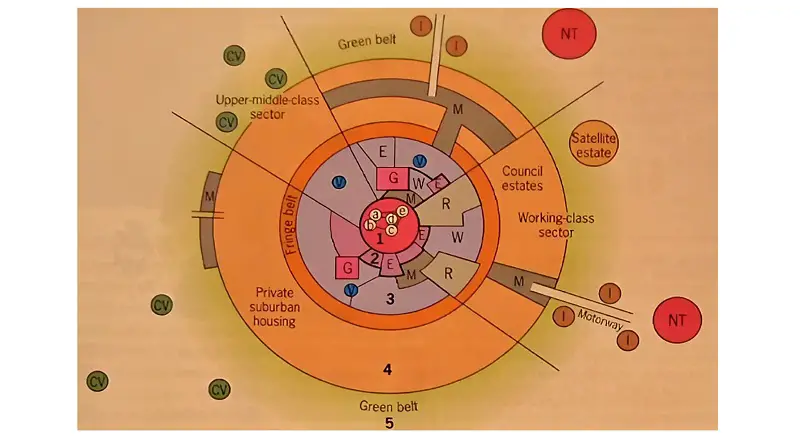The urban structure refers to the physical layout, organization, and design of a city or town. Urban structure is significant because it influences the way people interact with each other and with the built environment, as well as their access to resources, services, and opportunities. They provide the framework for how people live and work in a given area, and can have a large impact on the overall quality of life. Burgess model of concentric zones along with the sector model by Hoyt (1939) and the multiple nuclei by Harris and Ullman (1949) are the basic triad of urban structure models that are discussed in courses of urban studies as they are reflected in most Western cities.
Burgess Model is a theoretical urban spatial structure developed by geographer Ernest Burgess in 1925. Various geographers began re-evaluating Burgess’s model and updated his model with the contemporary urban structure of cities. Among them, one of the significant modifications was proposed by Kearsley in 1983.
Kearsley’s model of urban structure is a modified version of Burgess’ concentric zone model that described a typical American city having five concentric zones of land use. G. W. Kearsley stated that Burgess model is the basis for introduction to urban geography and the structure of a city. He noted (Kearsley, 1983):
“…it is felt that the basis for a modern and relevant introduction to urban geography can be built around the basic formulation in a way that retains the essential holism of structure and society that characterizes the modern metropolis.”
Rationale behind Kearsley’s model
Burgess model has been modified by Kearsley to better reflect changing demographics in cities over time, especially after the end of the Second World War, which characterized most of the Western cities. His model was, therefore, an attempt to extend Burgess’s model of urban structure to contemporary dimensions of urbanization such as the governmental involvement in urban development such as that in Britain, and other social patterns that influenced the character of the city. Some of these include: suburbanization, redevelopment and slum clearance, decentralization of economic activities, commuter villages, satellite towns, gentrification and ghettoization. Kearsley’s modified Burgess model offered elements such as the extension of inner-city blight, minimization of local and central government housing, and expansion of recent low-density suburbs, that presented a North American variant urban structure.
Kearsley’s model of urban structure
Kearsley’s model of the urban structure is a conceptual framework that describes the typical patterns of urban development in Western cities that started taking place in the 20th century post-war. Kearsley tried to adapt the Burgess model to include modern aspects of urban change such as inner city decline and decentralization. He also incorporated a few elements of sector and multiple nuclei models, and emphasized the divide between the inner city and out suburbs.
As the cities started growing, several processes characterized the city that varied from region to region. Extensive processes of clearances and redevelopments dominated the Britain cities in the 1950-60s that altered the visuals of the city with high-rise towers. These fossilized social patterns and the construction of suburban houses at the urban periphery facilitated the exodus of a social stratum.
The concept of new towns and satellite cities started coming to light in Britain, followed by France. This stimulated a deeper understanding of the background of commuter villages of the Burgess model and added a regional perspective to a single-city model.
Further, with the decanting of the high-density inner city, various traditional industries and other technological activities relocated to attractive rural locations, thereby making these activities a suburban or even exurban process and eventually leading to ‘de-urbanization’. With the commencement of de-urbanization, gentrification of the inner city became more prominent as affluent households seek to restore the fabric of inner-city environment. However, in response to the centralization of certain activities (especially in the tertiary sector), various centres in and around London retained the character as islands of middle-class rectitude. Around the same time, American cities also experienced a high influx of relatively disadvantaged people. Looking for cheap accommodation and jobs in inner city services industries and cultural influence, these formed identifiable ghettoes in the city. Gans (1962) pointed out that coherent social groups are visible in cities along with a clear distinction between inner cities and suburbs. He further stated that distinctive groups such as cosmopolites and ethnic villagers are recognized within the inner city representing the rich who choose to live close to the central business district (CBD), whereas the poor immigrant communities were found within the Twilight Zone.


Image: A modified Burgess model by Kearsley (1983)
Burgess model is predicated upon the principle of central land use where CBD is a prime resource sought by all land uses. Similarly, Alonso (1963) used bid-rent diagram to explain the pattern with CBD being the central land use. This modified version by Kearsley updated these basic formulations and made amendments to the Burgess model. His model emphasized the range of suburban, exurban and even regional developments that characterizes the western modern metropolitan structures.
Kearsley (1983) also discusses how different cities illuminate elements of various models. For instance, the cities in Europe are focused on the city centres, similar to the Burgess model. However, cities in America expand to suburban tracts, which are considered more significant in American cities as compared to city centres.
Conclusion
Kearsley’s modified Burgess model has been successfully implemented in many cities around the world, providing an effective tool for city planning. Despite its rigid structure, it still allows for changes that can be made quickly if needed. However, there are some limitations and challenges to consider when applying the model. It relies heavily on socio-economic data to determine which areas should have access to amenities or services and does not take into account cultural diversity or environmental impacts. Nevertheless, Kearsley’s Modified Burgess model accounts for suburban sprawl and exurban development, allowing us to gain insight into the entire metropolitan city structure.
Read related articles:
thanks for this short notes.